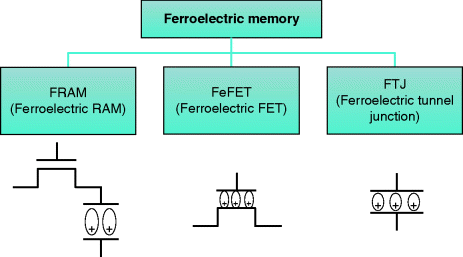6Ferroelectric FET Memory
Ken Takeuchi1 and An Chen2
1Chuo University, Japan
2GLOBALFOUNDRIES Inc., USA
6.1 Introduction
Ferroelectric materials have been utilized in commercial memories, for example, ferroelectric random access memory (FRAM), where a transistor-accessed ferroelectric capacitor store information in polarization directions [1–3]. Ferroelectric dielectrics can also be integrated in the gate stack of a field effect transistor (FET) whose channel conductance can be switched by modulation of the ferroelectric polarization, also known as a “Ferroelectric FET” (FeFET) [3–9]. Recently, the concept of ferroelectric tunnel junction (FTJ) was proposed as a memory element based on a very thin layer of ferroelectric tunnel barrier between two metal electrodes [10,11]. The tunneling current can be switched by ferroelectric reversal of the thin tunnel barrier. Figure 6.1 illustrates the three types of ferroelectric memories. Both FRAM and FTJ as memory devices combine an access transistor and a storage node, that is, 1-transistor-1-capacitor (1T1C) for FRAM and 1-transistor-1-resistor (1T1R) for FTJ. However, FeFET is an 1T memory, similar to Flash memory devices. FTJ will be discussed in detail in Chapter 9; this chapter focuses on FeFET.

Figure 6.1 Three types of ferroelectric memories
FeFET has attracted a lot of attention for both memory and logic applications. The nonvolatile ...
Get Emerging Nanoelectronic Devices now with the O’Reilly learning platform.
O’Reilly members experience books, live events, courses curated by job role, and more from O’Reilly and nearly 200 top publishers.

